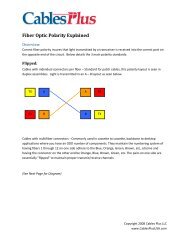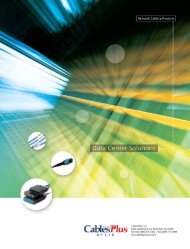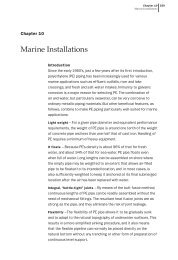Learning About Options in Fiber - Cables Plus USA
Learning About Options in Fiber - Cables Plus USA
Learning About Options in Fiber - Cables Plus USA
Create successful ePaper yourself
Turn your PDF publications into a flip-book with our unique Google optimized e-Paper software.
SECTION 3—REFERENCES<br />
Buffer Coat<strong>in</strong>g<br />
Buffer Tube<br />
Buffer<br />
Bus Network<br />
Byte<br />
Cable Assembly<br />
Cable Bend Radius<br />
Cable<br />
CCIT<br />
Central Member<br />
Channel Separation<br />
Channel<br />
Chromatic Dispersion<br />
Chrom<strong>in</strong>ance Signal<br />
Cladd<strong>in</strong>g<br />
Cleavers<br />
Coat<strong>in</strong>g<br />
A protective layer, such as an acrylic polymer, applied over the fiber cladd<strong>in</strong>g<br />
for protective purposes.<br />
A hard plastic tube hav<strong>in</strong>g an <strong>in</strong>side diameter several times that of a fiber that<br />
holds one or more fibers.<br />
A protective coat<strong>in</strong>g applied directly to the fiber such as a coat<strong>in</strong>g, an <strong>in</strong>ner<br />
jacket, or a hard tube.<br />
A network topology <strong>in</strong> which all term<strong>in</strong>als are attached to a transmission<br />
medium serv<strong>in</strong>g as a bus.<br />
A b<strong>in</strong>ary str<strong>in</strong>g (usually of 8 bits) operated as a unit.<br />
<strong>Fiber</strong>-optic cable that has connectors <strong>in</strong>stalled on one or both ends. General<br />
use of these assemblies <strong>in</strong>cludes the <strong>in</strong>terconnection of fiber-optic systems<br />
and opto-electronic equipment. If connectors are attached to only one end of<br />
a cable, it is known as a pigtail. If connectors are attached to both ends, it is<br />
known as a jumper.<br />
This term implies that the cable is experienc<strong>in</strong>g a tensile load. Free bend<br />
implies a smaller allowable bend radius s<strong>in</strong>ce it is at a condition of no load.<br />
One or more optical fibers enclosed with<strong>in</strong> protective cover<strong>in</strong>g(s) and strength<br />
members.<br />
See Consultative Committee on International Telegraph and Telephone.<br />
The center component of a cable, it serves as an antibuckl<strong>in</strong>g element to resist<br />
temperature-<strong>in</strong>duced stresses. Sometimes serves as a strength element. The<br />
central member is composed of steel, fiberglass, or glass-re<strong>in</strong>forced plastic.<br />
This specification describes how well a coupler can dist<strong>in</strong>guish wavelengths.<br />
A communications path or the signal sent over that channel. Through multiplex<strong>in</strong>g<br />
several channels, voice channels can be transmitted over an optical<br />
channel.<br />
This condition occurs because different wavelengths of light travel at different<br />
speeds. No transmitter produces a pure light source of only one wavelength.<br />
Instead, sources produce a range of wavelengths around a center wavelength.<br />
These wavelengths travel at slightly different speeds, result<strong>in</strong>g <strong>in</strong> pulse<br />
spread<strong>in</strong>g that <strong>in</strong>creases with distance.<br />
The portion of the NTSC color-television signal that conta<strong>in</strong>s the color <strong>in</strong>formation.<br />
The lower <strong>in</strong>dex-of-refraction material that surrounds the core of an optical<br />
fiber, caus<strong>in</strong>g the transmitted light to travel down the core.<br />
Tools which allow the operator to break or scribe the fiber with a 90 degree<br />
endface perpendicular to the axis of the fiber with little surface damage or<br />
irregularities to the fiber.<br />
Thermoplastic layer directly adhered to cladd<strong>in</strong>g to give flexibility and<br />
strength.<br />
3-6
















